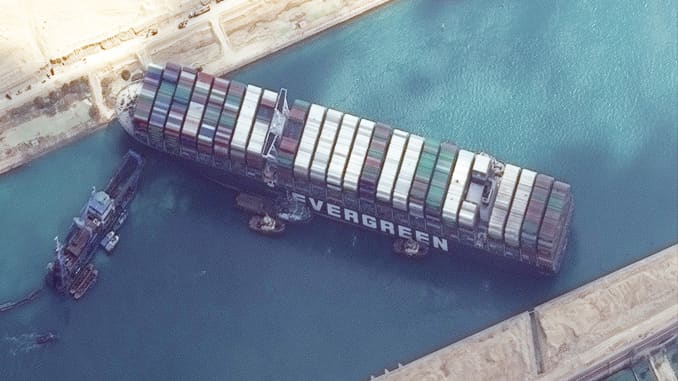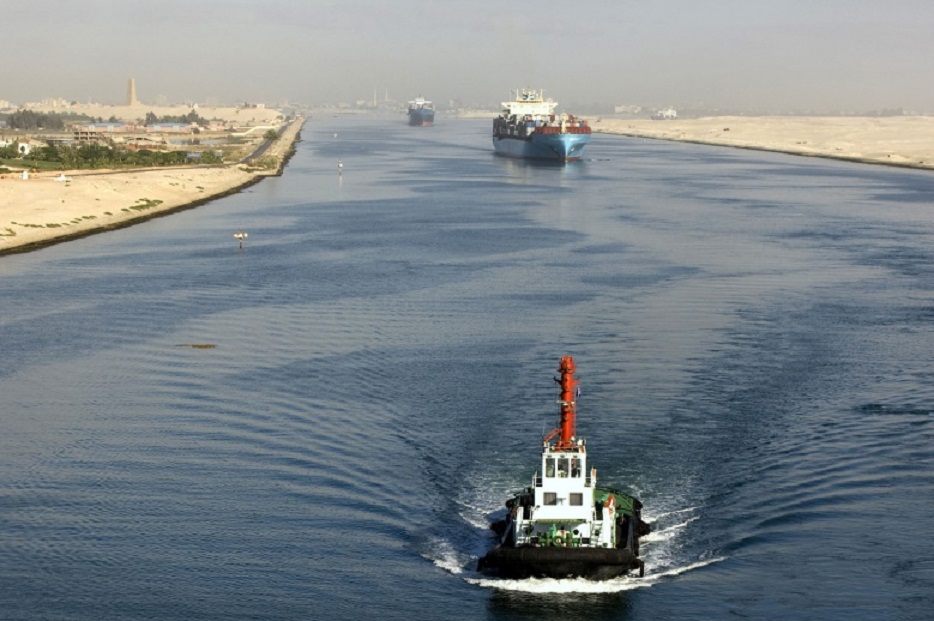Suez canal has taken centre stage after the grounding of the container ‘Ever Given’.
Twisting a dictum a bit one could say “One who rules the Suez rules the world (trade)”. The mishap which occurred in Suez Canal has proven its sensitivity and importance.
World trade worth 1 Trillion USD passes through Suez Canal annually (Topham, 2021). The blockage of the canal due to ship running aground has affected world trade and has had an impact on the prices including petroleum products.
Suez Canal- A historical Perspective
Suez Canal alias ‘Qanāt al-Suways’ in Arabic, is a vital sea-level waterway. It runs north-south across the Isthmus of Suez in Egypt to connect the Mediterranean and the Red seas. The Suez Canal which separates the African continent from Asia provides the shortest maritime route between Europe and the areas around the Indian and western Pacific oceans. Suez, one of the world’s busiest shipping lanes annually handles approximately 1139 million MT of the global trade (Smith, 2021) including petroleum products. Prior to its construction, which was completed in the year 1869, the only important settlement around was Suez which had 3,000 to 4,000 inhabitants then. Most of the towns along the canal have developed since, with a notable exception of Al-Qanṭarah.
The Suez Canal extends 193 km covering Port Said (Būr Saʿīd) in the north and Suez in the south. It has dredged approach channels north of Port Said, into the Mediterranean, and south of Suez. Interestingly this canal does not use the shortest route across the isthmus, which is only 121 km (75 miles). Instead of that canal utilizes several lakes-from north to south, Lake Manzala (Buḥayrat al-Manzilah), Lake Timsah (Buḥayrat al-Timsāḥ), and the Bitter Lakes—Great Bitter Lake (Al-Buḥayrah al-Murrah al-Kubrā) and Little Bitter Lake (Al-Buḥayrah al-Murrah al-Ṣughrā).
The Suez Canal, a novel feat of engineering, is an open cut and is without locks. Though the canal uses extensive straight stretches it has eight major bends. To the west of the canal is the low-lying delta of the Nile River and to the east is the higher, rugged, and arid Sinai Peninsula (Smith, 2021a).
Some Interesting Facts
The Isthmus of Suez, the sole land bridge between the continents of Africa and Asia, is of relatively recent geologic origin. Topographically, the Isthmus of Suez is not uniform. The area has three shallow water-filled depressions: Lake Manzala, Lake Timsah, and the Bitter Lakes; though distinguished as Great and Little, the Bitter Lakes form one continuous sheet of water. A number of limestone and gypsum band obtrude in the south of the isthmus. Another significant feature worth mentioning relates to a narrow valley leading from Lake Timsah south-westward toward the middle Nile Delta and Cairo. The isthmus comprises marine sediments, coarser sands, and gravels deposited in the early periods of abundant rainfall, Nile alluvium (especially to the north), and windblown sands (Smith, 2021b
Shortening of Sea Route
Benefits of the Suez Canal would we evident from the fact that before commissioning of the Canal ships from the UK to Gulf had to cover 20,900 Kms and the needed average of 24 days of transit which came down to 12000 Kms and 14 days respectively, a saving of 43% in terms of distance with associated saving in fuel burn and CO2 emissions. The ships transit through the Canal in 11-16 hrs (Smith, 2021c).
Capacity
In its first year of operation (1870), the canal handled 486 transits i.e. fewer than 2 per day. In 1966 this had increased to 21,250 transits at an average of 58 per day, with net tonnage increasing from some 444,000 metric tons (437,000 long tons) in 1870 to about 278,400,000 metric tons (274,000,000 long tons). As ships started becoming bigger the number of transits started reducing and by mid-1980 daily transits had come down to an average of 50, but net annual tonnage went up to about 355,600,000 metric tons (350,000,000 long tons). Now the canal handles approximately 18,174 transits in a year, with a net annual tonnage of about 1,139,630,000 metric tons (1,121,163,000 long tons). From this data, the increase in utility and importance of the canal becomes very evident (World Shipping Council, ND).
Blockage of Channel by Ships Running Aground
The canal was opened for operations, under French control in November 1869. The opening ceremonies began at Port Said on the evening of 15 November, with illuminations, fireworks, and a banquet. On the morning of 17 November, a procession of ships entered the canal, headed by the L’Aigle including ship ‘The Newport’. The Newport was involved in an incident that demonstrated some of the problems with the canal. There were some rumblings that the depth of parts of the canal at the time of the inauguration was not as good as promised. It was also feared that the deepest part of the channel was not always clear, leading to a risk of grounding. The first day of the passage ended at Lake Timsah, 76 kilometres (41 nm) south of Port Said. The French ship Péluse anchored close to the entrance, then swung around and grounded, the ship and its hawser blocking the way into the lake. The following boats had to anchor in the canal itself until the Péluse was hauled clear the next morning. This is the first recorded instance of the Canal blockage.
Between 1870 and 1884 some 3,000 groundings of ships occurred because of the narrowness and tortuousness of the channel. Major improvements began in 1876. After successive widenings and deepenings, the canal, by the 1960s, had a minimum width of 55 metres (179 feet) at a depth of 10 metres (33 feet) along its banks and a channel depth of 12 metres (40 feet) at low tide. Also in that period, passing bays were greatly enlarged and new bays constructed, bypasses were made in the Bitter Lakes and at Al-Ballāḥ, stone or cement cladding and steel piling for bank protection were almost entirely completed in areas particularly liable to erosion, tanker anchorages were deepened in Lake Timsah, and new berths were dug at Port Said to facilitate the grouping of ships in convoy.
Other Instances of Canal Blockage
The Suez Canal has since then witnessed trouble of blockage many times in its long history, sometimes shutting down for hours, days, weeks or — in one case— eight years. In 1937, the U.K.-bound ship Viceroy of India ran aground, causing a holdup for its 700 passengers and the vessels behind it. It shut down “all shipping” for a time. She was re-floated after part of the cargo was unloaded and Canal became operational.
A British freighter, the Lord Church, ran aground in September 1953, holding up six following ships and a year later a 10,000-ton tanker called the World Peace struck a railway bridge, causing another traffic tie-up. The World Peace, owned by a Greek company headed by the brother-in-law of Aristotle Onassis, managed to block the canal in 1955. More than 200 ships were forced to anchor while the problem, which was dealt with in three days.
One year later (Oct 1956), Egypt sparked a brief war when President Gamal Abdel Nasser nationalized the canal, which until then had been controlled by British and French interests. Britain, France and Israel attacked Egypt in retaliation. This ‘Suez Crisis’ as it became known was resolved in November by a United Nations peacekeeping force.
After that in Aug 1957, a 9,000-ton tanker called the Barbaros ran aground, damaged its rudder and held up traffic for nearly a day.
The stranded ‘Yellow Fleet’
A decade later, at the outbreak of the 1967 Arab-Israeli war — also known as the Six-Day War — Egypt closed the Suez Canal to international shipping traffic. More than a dozen cargo ships were stranded partway along the canal route for eight years. The canal reopened on June 5, 1975, with a ceremony attended by Egyptian President Anwar Sadat. Another grounding was reported in 2016 and a multi-ship collision in 2018, which blocked the Suez Canal (CBC Report, 2021).
Latest Incident
In the latest incident Massive container ship, owned by a Japanese company ran aground in Suez Canal, blocking the world’s busiest shipping route. The ship MV Ever Given is 400 metres (1,300ft) long, wedged diagonally across a canal not much more than 200 metres (656ft) wide. This ship kept around 300 ships waiting.
Satellite Image: MV Ever Given Stuck in Suez Canal

Image Courtesy: CNBC
As per reports, the Suez Canal stood blocked in both directions for traffic till 29 Mar 2021, by the ultra-large Golden-class container ship MV Ever Given. The ship, operated by Evergreen Marine, was en-route from Malaysia to the Netherlands when it ran aground reportedly after a strong gust of wind blew the ship off course. Upon running aground, Ever Given turned sideways, completely blocking the canal. Although part of the length of the canal is paralleled by an older narrower channel, which can still be used to bypass obstructions, this particular incident happened in a section of the canal with only one channel. A group of tugs, positioned on both sides of the ship could re-float Ever Given using tugs and the ship moved off the sandbanks of the canal.
Impact of Suez Canal Blockage on world Economy
It has been reported that the blockage is going to have an impact on cargo schedules around the world. Shipping companies are also considering diverting their ships along the much longer route around Cape Agulhas. The first container ship to do so is Ever Given’s sister ship, Ever Greet.
Many economists and trade experts have commented on the effects of the obstruction if not resolved quickly. It has been observed that the incident is likely to have a drastic impact on the global economy because of the trapped goods. Among the products, oil shipments are the most affected in the immediate aftermath, due to a significant amount of the remaining blocked with no way to reach their destination.
Impact on India and Action Plan
Centre chalks out four-point plan to deal with Suez Canal blockage
As seen from the above, over 300 vessels are waiting on the North and South sides of the Suez Canal and about 100 vessels are getting added to the queue on a daily basis. This route is used for Indian exports or imports worth $200 billion to or from North America, South America and Europe. This is expected to have an appreciable impact on the Indian economy.
Appreciating the situation, the Central Government of India has chalked out a four-point plan to deal with the Suez Canal blockage. This plan, prepared by the logistics division of the commerce ministry, comprises prioritisation of cargo, which will be done in order to ensure timely movement of perishable cargo.
“FIEO (Federation of Indian Export Organisations), MPEDA (Marine Products Exports Development Authority) and APEDA (Agricultural and Processed Food Products Export Development Authority (APEDA) will jointly identify cargo particularly perishable cargo for priority movement and work with the shipping lines for the same,” a commerce ministry statement said.
The CSLA (Cargo Intelligence Security and Logistics Associations) assured the freight rates as per existing contracts will be honoured. A request has been made to the shipping lines to maintain stability in freight rates during the period of this crisis. It was noted the situation is temporary and is unlikely to have a long-lasting impact. Shipping lines have been advised through the CSLA to explore the option of re-routing of ships via the Cape of Good Hope. It was pointed that such re-routing usually takes 15 additional days’ time.
The government expects that post clearance of blockage; some bunching may take place, especially at the ports of JNPT, Mundra and Hazira. The ministry of ports, shipping and waterway has assured to issue an advisory to these ports so as to gear up arrangements and ensure efficient handling during the forthcoming busy period. As per the Centre, this backlog should take about a week’s time to clear out (Business Today, 2021).
Some Suggested Measures to Avoid Marine Mishaps
The National Transportation Safety Board, in its 2016 Safety Board’s Safer Seas Digest, has tabulated the results of its investigations of major maritime accidents that have occurred in recent years. The publication was created to help mariners working at the deck plate level prevent future accidents and tragedies, and also help maritime executives develop and maintain a workplace environment of safety at sea. The document provides many valuable conclusions and lessons learned from the 27 investigated major maritime accidents and covers 10 different problem categories, all of which emphasize the multi-pronged threat that exists to transportation safety on the high seas(Scott, 2017):-
- Fatigue-The NTSB report indicates that fatigue is one of the most common reasons for transportation accidents, and reducing this cause should be a top priority for the mariners.
- Standard Maintenance and Repair Procedures-NTSB has recommended strict standardized procedures involving testing, repair and maintenance of equipment.
- Use of Medication While Operating Vessels- NTSB has cautioned that mariners should consult with an appropriate medical professional prior to using any type of medication, whether over-the-counter or prescribed, as use of certain medications by credentialed mariners may disqualify them from operating a vessel.
- Operational Testing Procedures- Report recommends that standardized procedures should always be used when testing equipment. All sensors and alarms within vessels should be tested routinely to verify the reliability of their operation and their capability of providing adequate warning to crew members.
- Familiarization with Local Recommendations- It’s important for vessel operators to have familiarity with and heed the recommendations of local specialists in the maritime industry as well as pertinent publications, including the Coast Pilot and others. Failure to do so may result in unnecessary accidents.
- Underestimating Strong Currents- Mariners can face significant challenges when operating in high water with currents that are more powerful than normal. Under such conditions, the ability to manoeuvre may be diminished significantly and the risk of parting lines or dragging anchor may be increased. It’s vital for operators and owners to encourage their mariners to properly assess dangers, and remain aware of prevailing conditions. As well, they must take into consideration the guidance of authoritative entities such as the Coast Guard – and from this information takes steps to minimize risks. In particular, the “down streaming” manoeuvre often performed by inland towers is risky when strong currents are present. Same precautions apply to strong wind conditions.
- Bridge Resource Management When pilots are faced with limited reaction times and hazards are close at hand, it’s important to have all possible resources available for use in order to help ensure the safe operation of vessels, including human resources and equipment. The utilization of these resources falls under Bridge Resource Management.
- Proper Safety Equipment- It’s vital that owners, operators and crewmembers of a vessel do their part to ensure the proper maintenance and functioning of safety equipment on the vessel.
- Distractions- NTSB advises minimising distractions as it concerns safety improvements. Although it is necessary for operators to communicate with dispatchers and crew members as well as conduct other work duties involving the checking of equipment and instruments, anything that hinders proper vessel operation can result in tragic outcomes.
- Access to High Risk Spaces-The NTSB emphasizes the importance of high risk spaces, in particular those with hull penetrations, remaining freely accessible. If these spaces are blocked, a safety hazard exists and operators may be hindered from responding to flooding and other types of emergencies when and if they occur.
Author is aware that a detailed investigation of the circumstances leading to grounding of MV Ever Given is necessary to determine exact causes and the remedial measures.
Conclusion
Suez Canal is important for the passage of world trade valued at 1 Trillion USD. Any disruptions to the free flow of trade in the canal can have a serious impact on the world and national economies. Learning from this incidence some measures could be put in place:-
- Familiarisation of crews of ships passing through the Canal with environmental conditions
- Pilots observing extra precautions while guiding extra-large ships.
- Promulgation of Standard Operating Procedures for the safety of ships while transiting the canal.
- Promulgate lesson from this particular incident for the future.
- Exploring the feasibility of having alternate bypass routes to avoid such situations.
Jai Hind.
Title image courtesy: Oleksandr Kalinichenko/Shutterstock.com
Disclaimer: The views and opinions expressed by the author do not necessarily reflect the views of the Government of India and Defence Research and Studies
References
- Topham Gwyn, 26 Mar 2021, Guardian, How the Suez canal blockage can seriously dent world trade. Retrieved from: https://www.theguardian.com/business/2021/mar/26/how-the-suez-canal-blockage-can-seriously-dent-world-trade, Accessed on 28 Mar 2021
- Smith Charles Gordan, 26 Mar 2021/a/b/c, Encyclopaedia Britannica, Suez Canal, Retrieved From: https://www.britannica.com/topic/Suez-Canal/The-economy
Accessed on 28 Mar 2021
- Report-World Shipping Council, ND, World Shipping Council, The Suez Canal –
A vital shortcut for global commerce, Retrieved from:
https://www.worldshipping.org/pdf/suez-canal-presentation.pdf, Accessed on 28 Mar 2021
- CBC Report, 27 Mar 2021, CBC News, Delays have lasted hours, days and even years in canal’s long history, Retrieved from:
https://www.cbc.ca/news/world/suez-canal-ships-delays-history-1.5964551
Accessed on 28 Mar 2021
- Michael Sheetz and Stevens Pippa, 26 Mar 2021, CNBC, imagery shows work underway to free ship Ever Given in the Suez Canal, Retrieved from:
https://www.cnbc.com/2021/03/26/satellite-images-of-ship-ever-given-in-suez-canal-shows-work-underway.html, Accessed on 28 Mar 2021
- Report Wikipedia, 23 Mar 2021, Wikipedia, Suez Canal, Retrieved from:
https://en.m.wikipedia.org/wiki/Suez_Canal, Accessed on 28 Mar 2021
- Staff Reporter, 27 Mar 2021, Business Today, Centre chalks out four-point plan to deal with Suez Canal blockage, Retrieved from:
https://www.businesstoday.in/current/economy-politics/centre-chalks-out-four-point-plan-to-deal-with-suez-canal-blockage/story/435041.html, Accessed on 28 Mar 2021
- Scott Krist, 28 Sep 2017, Ten Ways to Reduce the Risk of Maritime Accidents, Retrieved from: https://www.maritime-executive.com/editorials/ten-ways-to-reduce-the-risk-of-maritime-accidents, Accessed on 28 Mar 2021
Additional Reading
- Bain Mark, 27 Mar 2021, Quartz, The Suez Canal is the linchpin in the world’s trade network , Retrieved from: https://qz.com/1989788/why-the-suez-canal-is-vital-to-global-trade/, accessed on: 28 Mar 2021





